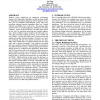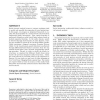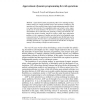111 search results - page 20 / 23 » Orthogonal Feature Learning for Time Series Clustering |
SIGMOD
2004
ACM
14 years 7 months ago
2004
ACM
Database system architectures are undergoing revolutionary changes. Most importantly, algorithms and data are being unified by integrating programming languages with the database ...
SIES
2008
IEEE
14 years 1 months ago
2008
IEEE
—Distributed, time-triggered communication based on FlexRay is likely to become an enabler for future safety related applications in the automotive domain. Prior to series deploy...
STOC
2001
ACM
14 years 7 months ago
2001
ACM
The dynamic behavior of a network in which information is changing continuously over time requires robust and efficient mechanisms for keeping nodes updated about new information. ...
ICMI
2010
Springer
13 years 5 months ago
2010
Springer
Social network analysis became a common technique used to model and quantify the properties of social interactions. In this paper, we propose an integrated framework to explore th...
21
Voted
ATMOS
2007
13 years 9 months ago
2007
Abstract. Approximate dynamic programming offers a new modeling and algorithmic strategy for complex problems such as rail operations. Problems in rail operations are often modeled...



